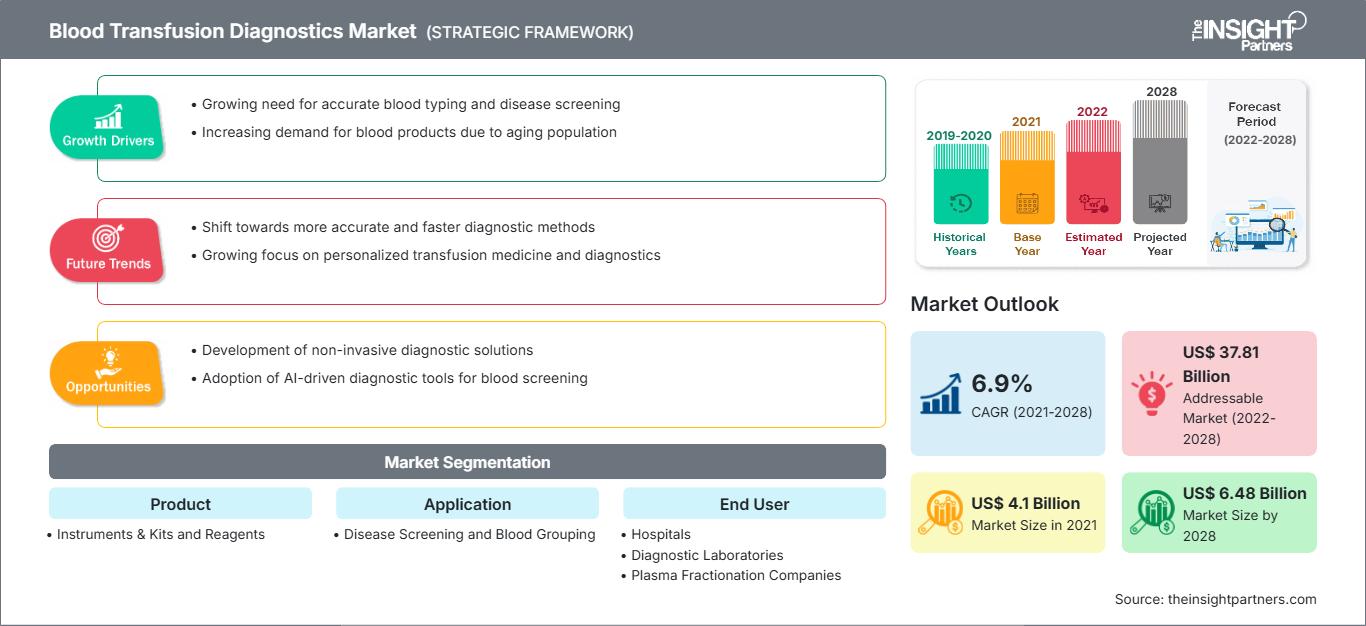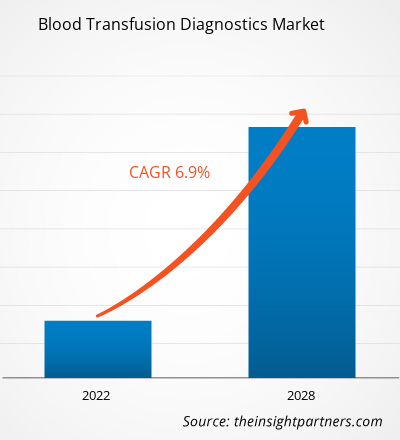[Rapport de recherche] Le marché du diagnostic de transfusion sanguine devrait passer de 4 096,93 millions de dollars américains en 2021 à 6 483,75 millions de dollars américains en 2028. Son taux de croissance annuel composé (TCAC) est estimé à 6,9 % entre 2022 et 2028.
Le diagnostic de transfusion sanguine est un test effectué sur le sang avant sa transfusion. Une transfusion sanguine est une procédure courante au cours de laquelle le sang donné ou ses composants sont transfusés dans le corps du patient par voie intraveineuse. Chaque unité de sang doit être soumise à un groupage sanguin, qui consiste à identifier le groupe sanguin et à effectuer des dépistages, notamment des tests de détection de maladies pour éviter les effets secondaires ou la transmission d'infections.
Le rapport offre des informations et une analyse approfondie du marché mondial du diagnostic de transfusion sanguine, en mettant l'accent sur divers paramètres, notamment les tendances du marché, les avancées technologiques, la dynamique du marché et l'analyse du paysage concurrentiel des principaux acteurs mondiaux. Il inclut également l'impact de la pandémie de COVID-19 sur le marché dans toutes les régions. La pandémie de COVID-19 a eu un impact négatif sur la croissance du marché mondial du diagnostic de transfusion sanguine. Elle a entraîné une forte baisse des revenus en raison des restrictions strictes imposées par le gouvernement, entraînant une diminution du nombre d'interventions chirurgicales pratiquées. Ces services sont principalement utilisés pour les interventions chirurgicales à fortes pertes sanguines, telles que les chirurgies orthopédiques et cardiaques. En raison de la diminution du nombre d'interventions pratiquées, la demande de transfusion sanguine a diminué. Par exemple, selon les données publiées par l'American Medical Association, on estime qu'il y a eu une réduction de 48 % du nombre total d'interventions chirurgicales pratiquées aux États-Unis en raison de la pandémie de COVID-19. Cependant, après la normalisation des restrictions liées à la pandémie, le volume des interventions chirurgicales est revenu à des niveaux normaux.
Personnalisez ce rapport en fonction de vos besoins
Vous bénéficierez d’une personnalisation sur n’importe quel rapport - gratuitement - y compris des parties de ce rapport, ou une analyse au niveau du pays, un pack de données Excel, ainsi que de profiter d’offres exceptionnelles et de réductions pour les start-ups et les universités
Marché du diagnostic de transfusion sanguine: Perspectives stratégiques

- Obtenez les principales tendances clés du marché de ce rapport.Cet échantillon GRATUIT comprendra une analyse de données, allant des tendances du marché aux estimations et prévisions.
Vous bénéficierez d’une personnalisation sur n’importe quel rapport - gratuitement - y compris des parties de ce rapport, ou une analyse au niveau du pays, un pack de données Excel, ainsi que de profiter d’offres exceptionnelles et de réductions pour les start-ups et les universités
Marché du diagnostic de transfusion sanguine: Perspectives stratégiques

- Obtenez les principales tendances clés du marché de ce rapport.Cet échantillon GRATUIT comprendra une analyse de données, allant des tendances du marché aux estimations et prévisions.
Informations géographiques
Sur le plan géographique, le marché mondial du diagnostic de transfusion sanguine est segmenté en Amérique du Nord (États-Unis, Canada et Mexique), Europe (France, Allemagne, Royaume-Uni, Espagne, Italie et reste de l'Europe), Asie-Pacifique (Chine, Inde, Japon, Australie, Corée du Sud et reste de l'APAC), Moyen-Orient et Afrique (Arabie saoudite, Émirats arabes unis, Afrique du Sud et reste de la région MEA) et Amérique du Sud et centrale (Brésil, Argentine et reste de l'Amérique du Sud et centrale).
Informations sur le marché
Besoin de transfusion sanguine en raison de l'augmentation des transplantations d'organes
La transplantation d'organe est une intervention chirurgicale pratiquée en cas de défaillance d'organe. En général, les transplantations d'organes concernent le cœur, le foie, les reins et divers autres organes, en raison de l'augmentation des cas de maladies chroniques, telles que l'insuffisance rénale chronique (IRC), la polykystose rénale, la mucoviscidose et les cardiopathies congénitales, qui nécessitent des transplantations. Ces interventions durent généralement plusieurs heures, entraînent d'importantes pertes sanguines et nécessitent des transfusions sanguines. Par exemple, selon l'United Network for Organ Sharing (UNOS), les transplantations d'organes réalisées aux États-Unis sont en constante augmentation, avec plus de 41 000 transplantations réalisées en 2021. De même, selon les données du Registre mondial des transplantations, l'Espagne représentait 20 % de tous les dons d'organes en Europe en 2019 et 6 % dans le monde. Le taux de donneurs d'organes en Australie s'est récemment amélioré, atteignant 21,8 donneurs par million d'habitants en 2019. De même, le Canada compte 22,2 donneurs par million d'habitants et ce chiffre est en constante amélioration, en partie grâce au chiffre des « médecins spécialistes des dons » : les médecins de soins intensifs responsables des dons d'organes. Selon le Registre mondial des transplantations, la Chine comptait 5 818 donneurs en 2019, soit 4,1 par million d'habitants, et l'Inde 715 donneurs, soit 0,5 par million d'habitants en 2019. En revanche, la Russie affichait un taux légèrement supérieur de 5,1 donneurs par million d'habitants. Le partenariat public-privé, en collaboration avec les coordinateurs de transplantation, a contribué de manière significative à l'amélioration des transplantations d'organes nécessitant une transfusion sanguine constante. Les pays en développement comme les pays développés ont constaté une augmentation des transplantations d'organes. Par exemple, les pays en développement, comme l'Inde et Singapour, émergent comme destinations de tourisme médical en Asie-Pacifique. Les pays progressent dans la fourniture de traitements médicaux plus performants et plus avancés. Le besoin croissant de transplantations d'organes est l'un des principaux facteurs à l'origine de la demande mondiale de diagnostics transfusionnels.
Informations produit
Le marché mondial du diagnostic transfusionnel se divise en deux catégories : instruments et kits, et réactifs. En 2021, le segment des instruments et kits représentait une part de marché plus importante. Ce même segment devrait enregistrer un TCAC plus élevé entre 2022 et 2028.
Informations application
Le marché mondial du diagnostic transfusionnel se divise en deux catégories : le dépistage des maladies et le groupage sanguin. Le segment du dépistage des maladies détenait une part de marché plus importante en 2021 et devrait enregistrer un TCAC plus élevé au cours de la période de prévision.
Aperçu régional du marché du diagnostic de transfusion sanguine
Les tendances régionales et les facteurs influençant le marché du diagnostic transfusionnel sanguin tout au long de la période de prévision ont été analysés en détail par les analystes de The Insight Partners. Cette section aborde également les segments et la géographie du marché du diagnostic transfusionnel sanguin en Amérique du Nord, en Europe, en Asie-Pacifique, au Moyen-Orient et en Afrique, ainsi qu'en Amérique du Sud et en Amérique centrale.
Portée du rapport sur le marché du diagnostic de transfusion sanguine
| Attribut de rapport | Détails |
|---|---|
| Taille du marché en 2021 | US$ 4.1 Billion |
| Taille du marché par 2028 | US$ 6.48 Billion |
| TCAC mondial (2021 - 2028) | 6.9% |
| Données historiques | 2019-2020 |
| Période de prévision | 2022-2028 |
| Segments couverts |
By Produit
|
| Régions et pays couverts | Amérique du Nord
|
| Leaders du marché et profils d'entreprises clés |
|
Densité des acteurs du marché du diagnostic de transfusion sanguine : comprendre son impact sur la dynamique commerciale
Le marché du diagnostic transfusionnel connaît une croissance rapide, porté par une demande croissante des utilisateurs finaux, due à des facteurs tels que l'évolution des préférences des consommateurs, les avancées technologiques et une meilleure connaissance des avantages du produit. Face à cette demande croissante, les entreprises élargissent leur offre, innovent pour répondre aux besoins des consommateurs et capitalisent sur les nouvelles tendances, ce qui alimente la croissance du marché.

- Obtenez le Marché du diagnostic de transfusion sanguine Aperçu des principaux acteurs clés
- Analyse historique (2 ans), année de base, prévision (7 ans) avec TCAC
- Analyse PEST et SWOT
- Taille du marché Valeur / Volume - Mondial, Régional, Pays
- Industrie et paysage concurrentiel
- Ensemble de données Excel
Rapports récents
Rapports connexes
Témoignages
Raison d'acheter
- Prise de décision éclairée
- Compréhension de la dynamique du marché
- Analyse concurrentielle
- Connaissances clients
- Prévisions de marché
- Atténuation des risques
- Planification stratégique
- Justification des investissements
- Identification des marchés émergents
- Amélioration des stratégies marketing
- Amélioration de l'efficacité opérationnelle
- Alignement sur les tendances réglementaires






















 Obtenez un échantillon gratuit pour - Marché du diagnostic de transfusion sanguine
Obtenez un échantillon gratuit pour - Marché du diagnostic de transfusion sanguine